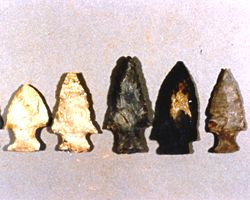Jaketown Site facts for kids
|
Jaketown Site
|
|

Roadside view of the site
|
|
| Nearest city | Belzoni, Mississippi |
|---|---|
| Area | 200 acres (81 ha) |
| NRHP reference No. | 73001017 |
Quick facts for kids Significant dates |
|
| Added to NRHP | June 19, 1973 |
| Designated NHL | December 14, 1990 |
The Jaketown Site (also known as 22 HU 505) is an amazing archaeological site in Humphreys County, Mississippi. It's a place where scientists study the past by digging up old objects. Here, you can find two large earthwork mounds built by ancient people. These mounds are like big hills made by hand.
Scientists believe the mounds were built and used between 1100 CE and 1500 CE. This was during a time known as the Mississippian culture. They know this from pieces of pottery found nearby. But people lived at Jaketown much, much earlier too!
Contents
Exploring Jaketown's Ancient History
The Jaketown Site was a very important place for trade a long time ago. It was a busy center from about 2000 BCE to 600 BCE. This earlier period is called the Poverty Point culture. It was part of the Late Archaic period in North America.
The Poverty Point Culture
The Poverty Point culture was spread across more than 100 sites. These sites were on both sides of the Mississippi River. They stretched from what is now Louisiana to Mississippi. Jaketown was a key part of this network.
People at Jaketown traded raw materials. They also made finished items there. These goods were then sent out through a huge trading network. This network reached across the entire Eastern United States. The biggest and most complex earthwork site from this time is Poverty Point in Louisiana.
Mounds and Their Purpose
The large mounds you see today were built later. They were created by a different group of people. These mounds marked the main political and religious center of a chiefdom. A chiefdom was like a small kingdom led by a powerful chief.
Important leaders likely lived near these mounds. There were also buildings for people who made special crafts. Because Jaketown was such an important trade center for the Poverty Point culture, it was made a National Historic Landmark in 1990. This means it's a very special historical place.
Discovering Artifacts and Old Structures
The Jaketown Site has been home to people for a very long time. It was continuously lived in from about 1750 BCE to 1500 CE. This makes it one of the oldest continuously inhabited places in the region.
What We've Found
Many artifacts have been found near the site. These are old objects that tell us about the past. You can see some of these amazing finds at the Jaketown Museum in Belzoni.
Archaeologists have also found evidence of smaller mounds. These mounds were actually hundreds of years older than the two that survive today. Sadly, these older mounds were destroyed. Farmers plowed them down, and some were used as fill for road construction in the early 1900s.
The Surviving Mounds
The biggest mound at the site is called Mound B. It is a large platform mound. Mound B stands about 23 feet (7 meters) tall. Its base is about 150 feet (46 meters) by 200 feet (61 meters). On its eastern side, there's a part that sticks out. Experts think this was once a ramp or stairway.
To the northwest of Mound B is Mound C. This is another platform mound. It is about 15 feet (4.6 meters) tall. These mounds give us clues about the ancient people who lived and thrived at Jaketown.
Images for kids






